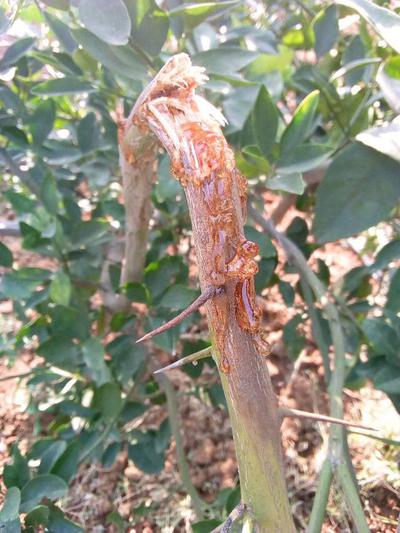Gummosis of Citrus
Phytophthora spp.
Fungus
In a Nutshell
- Dark water-soaked areas in the bark extending from the soil line.
- Water-soluble gum exuding from cracks in bark in dry weather.
- Bark below soil is water-soaked, slimy and reddish-brown to black.
- Necrotic areas can extend to inner tissues and encircle the bark, leading to collapse.
Can also be found in
Symptoms
Symptoms of foot rot or gummosis often start appearing near the soil line. Dark water-soaked areas are formed in the bark and a sour smell may emanate from them in wet conditions. Water-soluble gum exudes from longitudinal cracks in the bark, especially in dry weather. Bark below the soil line turns water soaked, slimy, reddish-brown, or black in late stages. Brown necrotic areas can extend to internal tissues of wood. Foliage turns yellow due to nutrition deficiency. At later stages, the dead bark dries, shrinks and cracks and patches may fall off, leaving an open canker. Trees may collapse and die if the fungus encircles the bark. Infected fruits develop a soft brown rot that eventually produces a characteristic pungent odor.
Recommendations

Organic Control
Exposing the seeds to hot water (about 49 degrees) for 4-10 minutes eradicates seedborne infection. The insertion of chlorine into micro-irrigation systems effectively reduces Phytophthora infections. Some fungal or bacterial species (Trichoderma spp. and Bacillus spp.) have been tested as control agents for Phytophthora with good results. Copper fungicides can also be used to control the disease at early stages.

Chemical Control
Always consider an integrated approach with preventive measures together with biological treatments if available. The treatment of the orchard with fungicides containing metalaxyl and fosetyl-aluminium is an effective complement to preventive and biological control of the fungus. Foliar applications of fosetyl-aluminium and a soil drench of metalaxyl showed very good results. Both preharvest sprays, postharvest dip treatments and/or the use of impregnated wrappers is recommended.
What caused it?
The symptoms are caused by different species of Phytophthora fungi. They produce a large number of water-borne spores that under favorable conditions (high moisture and elevated temperatures) can swim over short distances. These spores are the infective agents that may be transported in rain or irrigation to the roots of the trees. They germinate and enter the root tip resulting in rot of the entire rootlet, later extending to the rest of the root. Foot rot or gummosis occur when these spores are splashed onto a wound or bark crack around the base of the trunk. The susceptibility of the tree depends on the Phytophthora species present and is greatly influenced by the prevailing environmental conditions (type of soil, presence of water).
Preventive Measures
- Sow seeds from certified sources.
- Select resistant or tolerant varieties for the orchard.
- The nursery site should be well drained.
- Make sure that tools are disinfected before use.
- Plant the trees on cambered beds to prevent losses from the disease.
- Avoid wounding, especially near the trunk base.
- Remove dead or infected tree material immediately.
- Inspect the orchard regularly for signs of the disease down to the first lateral roots.
- Avoid contact between furrow irrigation water and the trunk of trees.



